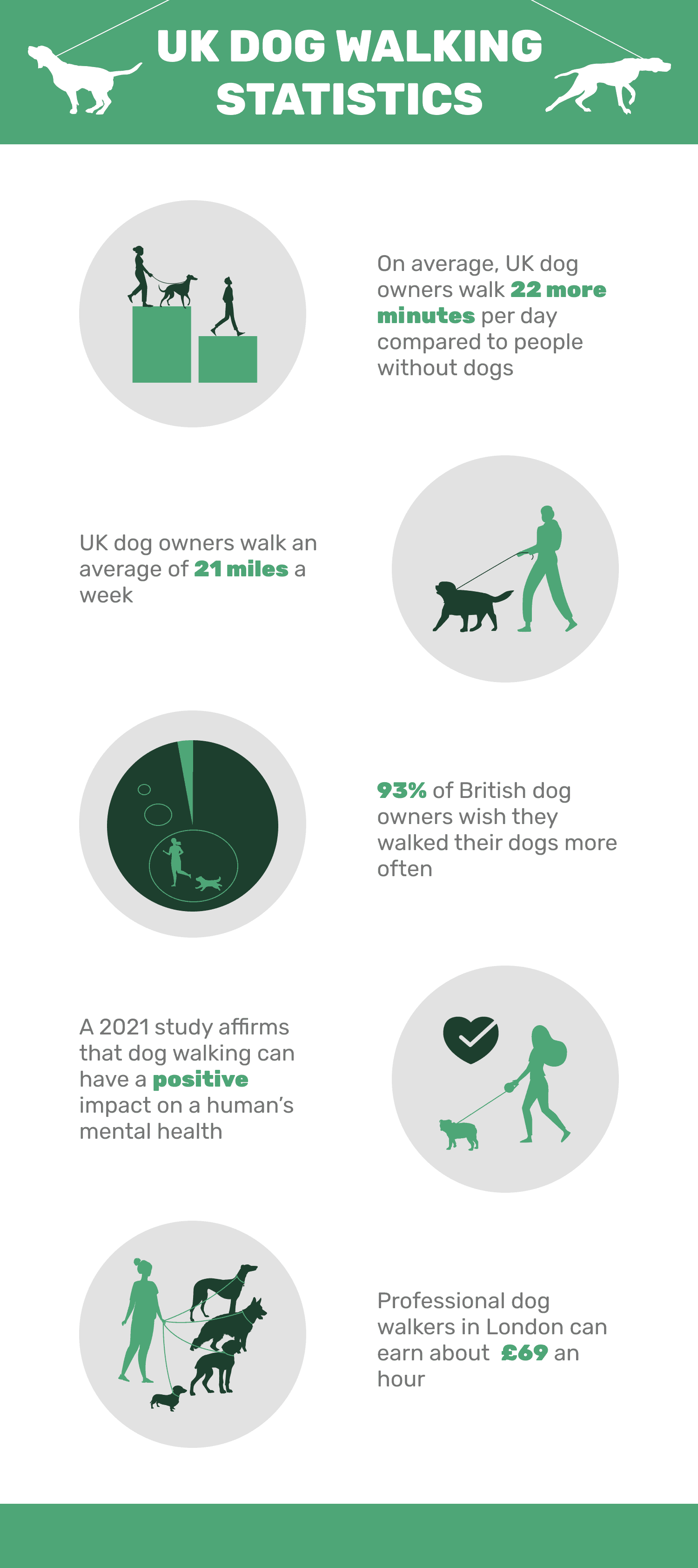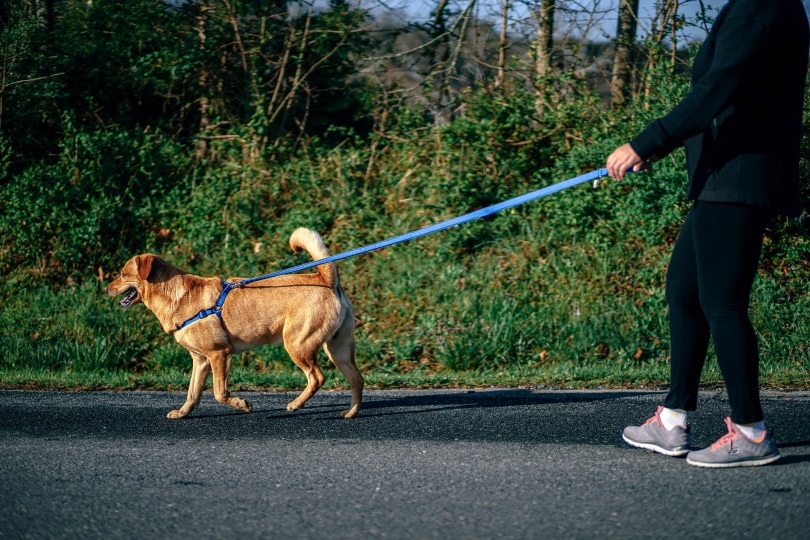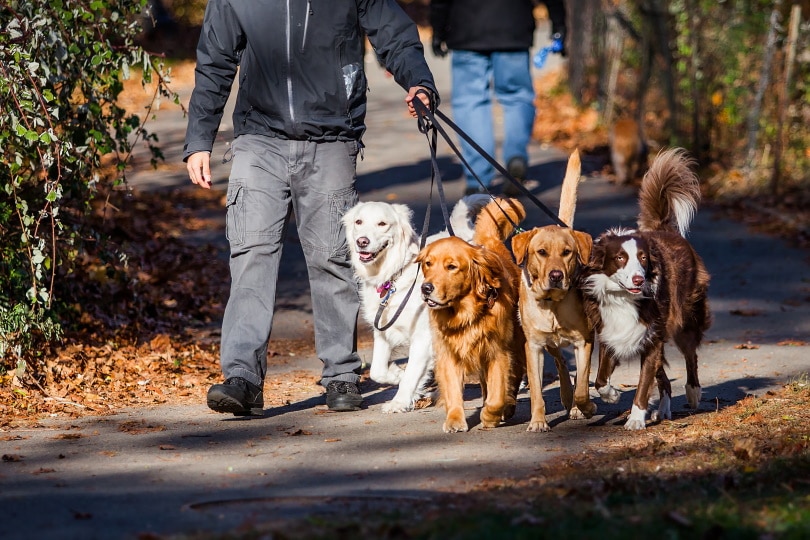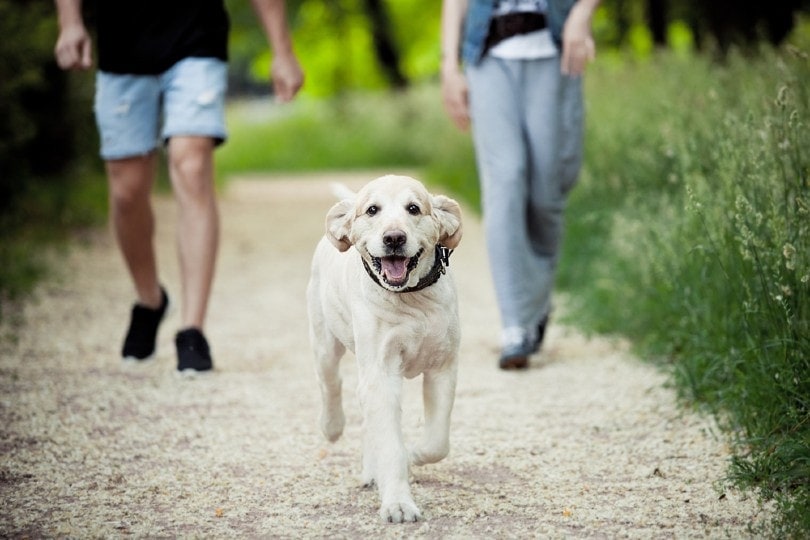Click to Skip Ahead
This article’s statistics come from third-party sources and do not represent the opinions of this website.
One of the most common lifestyle changes that many new dog owners experience is increased walking. In general, dogs love going on walks because it’s an enriching activity where they can indulge their curious and social natures. On average, UK dog owners walk an average of 2 miles a day.
Dog walking has many benefits, and many dog walkers enjoy participating in this activity to bond with their dogs. However, the world of pets changed immensely with the COVID-19 pandemic and the surge of pet adoptions. So, naturally, dog walks and how people walk their dogs have changed as well.
With such recent and ongoing changes, we compiled up-to-date facts and statistics on dog walking in the UK including:
The 10 UK Dog Walking Statistics
- A Lintbells survey reported that UK dog owners walk an average of 21 miles a week.
- On average, dog owners walk 22 more minutes per day compared to people without dogs.
- Dog owners are more likely to meet physical activity guidelines than people without a dog.
- A 2021 study affirms that dog walking can have a positive impact on a human’s mental health.
- 93% of British dog owners wish they walked their dogs more often.
- COVID-19 lockdowns provided particular challenges for dog owners with high-energy dogs due to reduced dog walking options.
- During the pandemic, dogs are reportedly walked less frequently, but the amount of time spent on walks hasn’t drastically reduced.
- During the pandemic, the number of dog thefts rose significantly and dog walkers became common targets.
- Dog walking services project an increase in business profits with the surge of pandemic puppies needing walks as their owners return to the office.
- Professional dog walkers in London can earn about £10.69 an hour.

The 5 Benefits of Dog Walking Statistics
1. A Lintbells survey reported that UK dog owners walk an average of 21 miles a week.
(Lintbells)
On average, dog owners in the UK walk their dogs for about 2 miles a day and many dog owners state that they can walk further since they got a dog. In comparison, non-dog owners travel less than 14 miles a week.
This study also revealed that 46% of non-dog owners believe they would walk more if they had a pet to walk.

2. On average, dog owners walk 22 more minutes per day compared to people without dogs.
(BMC Public Health)
This study conducted by BMC Public Health showed that dog owners can walk over 2,700 more steps a day than people who don’t own dogs. Not only that, they tend to walk at a moderate cadence, since dogs tend to walk faster than humans.
The findings suggest that dog ownership can greatly benefit older adults because the moderate cadence of a dog walk is an appropriate form of exercise for this age group.
3. Dog owners are more likely to meet physical activity guidelines than people without a dog.
(NIH)
This 2019 study found data that indicated that dog owners are more likely to meet healthy and appropriate physical activity guidelines than non-dog owners. Many dog owners also pair their dog walking responsibilities with recreational activities, such as exploring a neighborhood, going hiking, jogging, or running with their dogs.
A dog is a good motivator for people to stay active, and they’re also great companions for recreational activities.
4. A 2022 study affirms that dog walking can have a positive impact on a human’s mental health.
(Frontiers in Veterinary Science)
This comprehensive study provides evidence of the many ways that dogs can have a positive impact on people’s mental health and wellbeing. Dog walks help people be physically active, and walking can reduce the risk of cardiovascular disease and stroke. Walking can even reduce the risk of people becoming depressed by 30%.
Dog walking can help people feel more socially connected when others stop to greet their dogs or when they walk to the dog park. People also often think of suburbs as friendlier if they see dogs walking around the neighborhood.

5. 93% of British dog owners wish they walked their dogs more often.
(Forthglade)
A survey completed by Forth revealed that dog owners wish they could walk their dogs more, but there are different barriers that get in the way. Some dog owners expressed that they’re too busy or that rainy days really deter their motivation to walk their dogs.
Walks are categorized into two types: functional walks and recreational walks. The purpose of functional walks is to meet the basic needs of a dog. They’re the types of walks that dog owners go on to let their dogs relieve themselves and burn some energy.
On the other hand, recreational walks are for pure entertainment. They can be leisurely walks where dogs can stop and sniff every tree, or they can be hikes. Dog owners who find ways to make walks more recreational tend to walk their dogs more often.
The 3 Most Surprising Dog Walking and the COVID-19 Pandemic Statistics
6. COVID-19 lockdowns provided particular challenges for dog owners with high-energy dogs due to reduced dog walking options.
(Environmental Research and Public Health)
Although dogs have helped many people feel less lonely, dog owners faced challenges with dog walking in the midst of the pandemic. In general, dog walks became less enjoyable. Dogs were less likely to walk off-leash and weren’t allowed to socialize with other dogs because of social distancing.
Seasoned dog owners also perceived that new dog owners didn’t respect social distancing and reported that their new dogs’ behaviors seemed “out of control.”
Other dog owners felt worried about contracting COVID-19 during a walk, especially when the research wasn’t readily available about cross-species transmission.
7. During the pandemic, dogs are reportedly walked less frequently, but the amount of time spent on walks hasn’t drastically reduced.
(PDSA)
Throughout the pandemic, fewer dogs walked more than one time a day compared to 2019. Before the pandemic, dogs tended to walk more times throughout the day for shorter durations. During the pandemic, dogs started to walk just once a day but for a longer time.
Therefore, the amount of time a dog walked per week hasn’t changed drastically from previous years.

8. During the pandemic, the number of dog thefts rose significantly and dog walkers became common targets.
(TIME)
With the rise in pet adoptions, pet thefts skyrocketed within the past two years. DogLost, an organization that works to reunite dogs with their owners, reported a 170% increase in dog thefts in the UK. In 2021 alone, DogLost recorded 106 dog stolen dogs, a significant increase from 2019’s 55 stolen dogs.
Some dog thefts occur during dog walks, while others happen when dogs are playing in their yard.
The 2 Newest Professional Dog Walking Statistics
9. Dog walking services project an increase in business profits with the surge of pandemic puppies needing walks as their owners return to the office.
(Bloomberg)
Many large dog walking businesses anticipate an increased demand for dog walking services. The rise of pandemic puppies and people having to return to work in offices is the perfect combination for dog walking businesses to market their services.
These businesses generally saw a decline in bookings in 2020. However, 2021 started to show a steady increase. Now, Rover anticipates a significant jump in revenue and predicts 2022 to bring in $8.1 million in revenue.

10. Professional dog walkers in London can earn about £10.69 an hour.
(UK Indeed)
Dog walking is becoming a popular option for people to earn extra cash or start a new career. According to Indeed, dog walkers in London earn an average of a little less than £11.
However, prices can increase based on the neighborhood as well as the dog walker’s experience. If you book clients through an app, such as Pawshake, you can often set your own prices and schedule.
Frequently Asked Questions
How much do people walk their dogs?
On average, dog owners in the UK walk their dogs about 34 minutes a day and walk about 1,000 miles a year.
Not all dogs require the same amount of exercise. However, dogs should walk at least a minimum of 20 minutes a day. Smaller dog breeds and brachycephalic dogs, such as pugs and bulldogs, don’t require long walks. They can do well with 20-minute walks, and too much strenuous exercise can be bad for them because they can overheat easily.
More active dogs will require 1-2 hours of exercise a day, and a daily walk just might not cut it. Walks can help dogs burn energy and stimulate their minds, especially if they stop to sniff around and explore. However, sometimes, they just need to run around and play with other dogs or chase a ball. (Academy Animal)

How many people don’t walk their dogs?
It’s unclear as to how many people don’t walk their dogs. However, some studies show that not all dog owners regularly walk their dogs. (Health Promotion International)
Dog owners have several reasons why they don’t walk their dogs. Sometimes, it’s due to rainy or inclement weather. Other times, it’s not enjoyable because their dogs pull on leashes. (Forthglade)
Do dogs get bored of the same walk?
It depends. Some dogs are creatures of habit and enjoy sticking to a predictable walk. Other dogs with more inquisitive natures will get bored if you go on the same route every day.
You can switch things up and go on different routes. If your dog’s resistant, then it’s probably best for them to stick with their usual route. If you have limited walking paths, you can also include games and training sessions with treats at random intervals throughout the walk. (Modern Dog Magazine)
Do walks make dogs happy?
Yes, dogs usually love going on walks. Even if you have a backyard for your dog to run around in, dogs will typically enjoy walks more. Backyard romps are more supplemental activities for walks. Having your dog run around the yard and expend some energy can help them have calmer walks.
Dogs are naturally curious, and walks provide many enrichment opportunities as they sniff around and investigate different spots. They might not expend as much physical energy on walks, but they receive a lot of mental stimulation that keeps them engaged and can even tire them out. (PetMD)

Why doesn’t my dog want to walk?
Dogs may not enjoy walks for several reasons. First, puppies often may not like walks because it can feel too overwhelming if they’re too far from home. They may also feel like the leash is too restraining. (The Bark)
If your dog doesn’t want to go on a walk, make sure to first check if your dog’s experiencing any pain. Check for any limping or any tenderness, especially in their joints.
Most dogs that don’t enjoy walks often have had negative experiences with walks that discourage them from wanting to do it again. They might have walked on days that were too hot or cold. They could have also encountered an aggressive dog on one of the walks.
Dogs can also become disinterested in walks if they’re too long. Not all dogs need hour-long walks twice a day. Some just need 20 minutes.
If dogs become resistant to walks, it’s important to find the root cause. It’s also important to be patient and work in increments so that your dog has time to become comfortable with walks. Show your dog that walks are fun by dropping some of their favorite treats along the way and praising them throughout the walk. (PetMD)
What do you do when you can’t walk your dog?
Dog owners don’t have to be hard on themselves if they miss a walk. Sometimes, it’s not possible to go on a walk. There might be extreme weather outside, or you could also have an injury that requires you to rest.
Fortunately, there are some alternatives to walks that you can use as temporary substitutes. First, let your dog play with interactive puzzle toys or treat-dispensing toys. These types of toys keep your dog’s mind engaged, which can tire them out. You can also play a game of tug indoors, practice obedience training commands, or teach your dog a new trick.
If your dog desperately needs a walk, there are many dog walking services with professional and vetted dog walkers that are more than willing to help out. (VetStreet)
Conclusion
Walks play an essential role in a dog’s life. They provide physical exercise and mental stimulation, and they challenge and activate natural instincts.
The pandemic has affected the walking experience for both dog owners and their dogs. We may have to learn how to adapt and modify walks to fit into a post-pandemic lifestyle. However, they can still be valuable moments that strengthen the bond between dogs and humans.
Featured Image Credit: Jaromir Chalabala, Shutterstock













